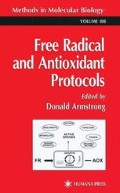Abstract
It has been reported that in a system containing microsomal phospholipids, nicotinomide adenine dinucleotide phosphate (NADPH), Fe3+-ADP complex and cytochrome P-450 reductase (a reconstituted microsomal lipid peroxidation system), excited carbonyl species and singlet molecular oxygen, (1O2 may generate according to Russell’s proposed mechanism (Reaction 1). In the present study, generation of excited carbonyls was verified by their energy being transferred to dyes containing heavy atoms in their molecules. A possible mechanism for the generation of excited species and the energy transfer from excited carbonyls to dye molecules leading to the formation of excited dye molecules is outlined on p. 370 where LH, L•, LOO•, L′=O* and Dye* represent unsaturated lipids, lipid radicals, lipid peroxy radicals, excited carbonyls in triplet states, and excited dye in singlet state Reaction 4 is forbidden, but proceeds because of heavy atom perturbation (1). Thus, the excited carbonyl species formed during lipid peroxidation may transfer their energy to dye molecules containing heavy atoms such as Rose Bengal to produce singlet dye molecule in excited state. The excited Rose Bengal then emits a photon to return to its ground state. The aim of this chapter is to describe the relationship between Rose Bengal-dependent luminescence and 02 consumption in a methemoglobin (MetHb)-induced lipid peroxidation system and demonstrate how the reaction is quenched by α-tocopherol or probucol present in phospholipid liposomes.
Access this chapter
Tax calculation will be finalised at checkout
Purchases are for personal use only
References
Sugioka, K. and Nakano, M. (1976) A possible mechanism of the generation of singlet molecular oxygen in NADPH-dependent microsomal lipid peroxidation. Biochim Biophys. Acta 423, 203–216
Folch, J., Lees, M, and Sloane-Stanley, G. H (1957) A simple method for the isolation and purification of total lipides from animal tissues. J. Biol Chem. 226, 497–509.
Hanahan, D. J., Dittmer, J. C, and Warashina, E. (1957) A column chromatographic separation of classes of phospholipides. J. Biol. Chem. 228, 685–700.
Sugioka, K. and Nakano, M. (1982) Mechanism of phospholipid peroxidation induced by ferric ion-ADP-adriamycin-coordination. complex. Biochim. Biophys. Acta 713, 333–343.
Williams, Jr., R. C. and Tsay, K, Y. (1973) A convenient chromatographic method for the preparation of human hemoglobin. Anal. Biochem. 54, 137–145.
Tomoda, A., Matsukawa, S., Takeshita, M., and Yoneyama, Y. (1976) Effect of organic phosphates on methemoglobin reduction by ascorbic acid. J. Biol. Chem. 25, 7494–7498.
Hegesh, E. and Avron, M (1967) The enzymatic reduction of ferrihemoglobin. Biochim. Biophys Acta 146, 91–101.
Szebeni, J., Winterbourn, C. C, and Carrell, R. W (1984) Oxidative interaction between haemoglobin and membrane lipid. Biochem J. 220, 685–692.
Author information
Authors and Affiliations
Editor information
Editors and Affiliations
Rights and permissions
Copyright information
© 1998 Humana Press Inc., Totowa, NJ
About this protocol
Cite this protocol
Nakano, M., Ito, T., Hiramitsu, T. (1998). A Simple Luminescence Method for Detecting Lipid Peroxidation and Antioxidant Activity In Vitro. In: Armstrong, D. (eds) Free Radical and Antioxidant Protocols. Methods in Molecular Biology™, vol 108. Humana Press. https://doi.org/10.1385/0-89603-472-0:369
Download citation
DOI: https://doi.org/10.1385/0-89603-472-0:369
Publisher Name: Humana Press
Print ISBN: 978-0-89603-472-3
Online ISBN: 978-1-59259-254-8
eBook Packages: Springer Protocols

